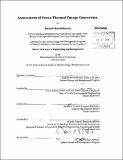| dc.contributor.advisor | E. Eric Adams, Jessika E. Trancik, and Ricardo Valerdi. | en_US |
| dc.contributor.author | Muralidharan, Shylesh | en_US |
| dc.contributor.other | System Design and Management Program. | en_US |
| dc.date.accessioned | 2013-02-14T15:18:28Z | |
| dc.date.available | 2013-02-14T15:18:28Z | |
| dc.date.copyright | 2012 | en_US |
| dc.date.issued | 2012 | en_US |
| dc.identifier.uri | http://hdl.handle.net/1721.1/76927 | |
| dc.description | Thesis (S.M. in Engineering and Management)--Massachusetts Institute of Technology, Engineering Systems Division, System Design and Management Program, 2012. | en_US |
| dc.description | Cataloged from PDF version of thesis. | en_US |
| dc.description | Includes bibliographical references (p. 103-109). | en_US |
| dc.description.abstract | Ocean thermal energy conversion (OTEC) is a promising renewable energy technology to generate electricity and has other applications such as production of freshwater, seawater air-conditioning, marine culture and chilled-soil agriculture. Previous studies on the technology have focused on promoting it to generate electricity and produce energy-intensive products such as ammonia and hydrogen. Though the technology has been understood in the past couple of decades through academic studies and limited demonstration projects, the uncertainty around the financial viability of a large-scale plant and the lack of an operational demonstration project have delayed large investments in the technology. This study brings together a broad overview of the technology, market locations, technical and economic assessment of the technology, environmental impact of the technology and a comparison of the levelized costs of energy of this technology with competing ones. It also provides an analysis and discussion on application of this technology in water scarce regions of the world, emphasized with a case study of the economic feasibility of this technology for the Bahamas. It was found that current technology exists to build OTEC plants except for some components such as the cold water pipe which presents an engineering challenge when scaled for large-scale power output. The technology is capital intensive and unviable at small scale of power output but can become viable when approached as a sustainable integrated solution to co-generate electricity and freshwater, especially for island nations in the OTEC resource zones with supply constraints on both these commodities. To succeed, this technology requires the support of appropriate government regulation and innovative financing models to mitigate risks associated with the huge upfront investment costs. If the viability of this technology can be improved by integrating the production of by-products, OTEC can be an important means of producing more electricity, freshwater and food for the planet's increasing population. | en_US |
| dc.description.statementofresponsibility | by Shylesh Muralidharan. | en_US |
| dc.format.extent | 113 p. | en_US |
| dc.language.iso | eng | en_US |
| dc.publisher | Massachusetts Institute of Technology | en_US |
| dc.rights | M.I.T. theses are protected by
copyright. They may be viewed from this source for any purpose, but
reproduction or distribution in any format is prohibited without written
permission. See provided URL for inquiries about permission. | en_US |
| dc.rights.uri | http://dspace.mit.edu/handle/1721.1/7582 | en_US |
| dc.subject | Engineering Systems Division. | en_US |
| dc.subject | System Design and Management Program. | en_US |
| dc.title | Assessment of ocean thermal energy conversion | en_US |
| dc.title.alternative | Assessment of OTEC | en_US |
| dc.title.alternative | Ocean thermal energy conversion as a viable source of renewable energy | en_US |
| dc.type | Thesis | en_US |
| dc.description.degree | S.M.in Engineering and Management | en_US |
| dc.contributor.department | System Design and Management Program. | en_US |
| dc.contributor.department | Massachusetts Institute of Technology. Engineering Systems Division | |
| dc.identifier.oclc | 824363276 | en_US |
